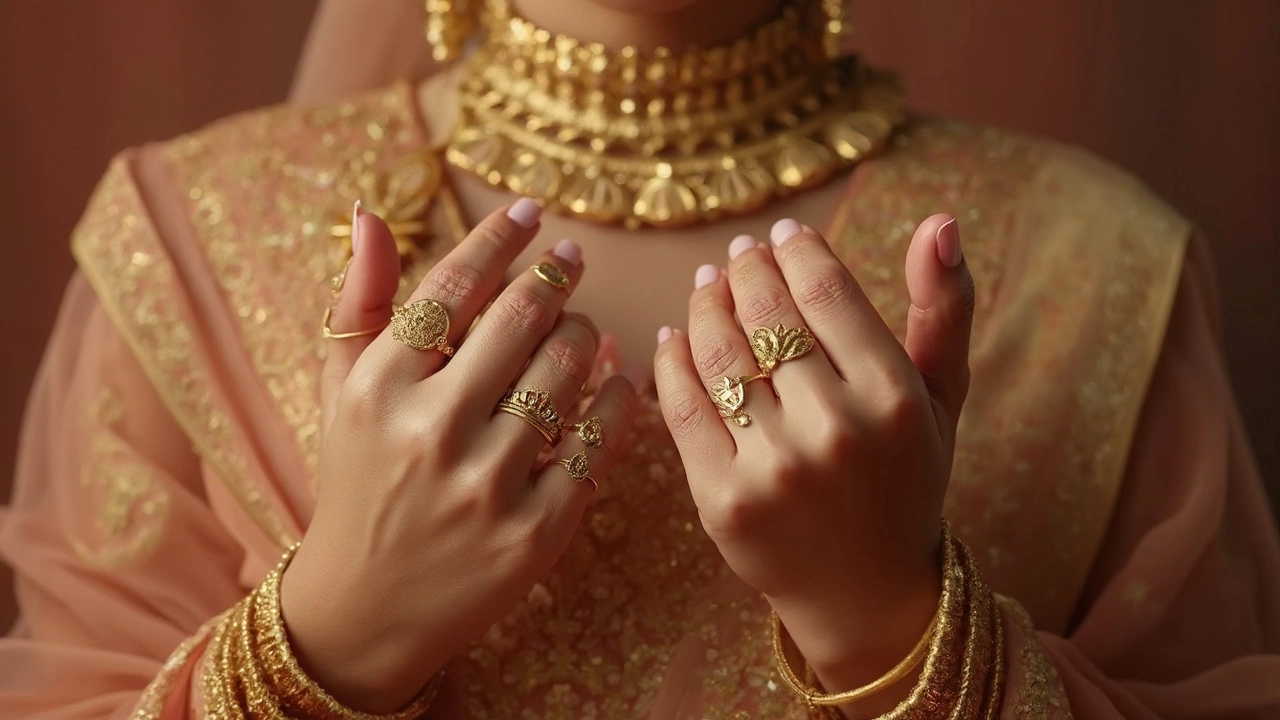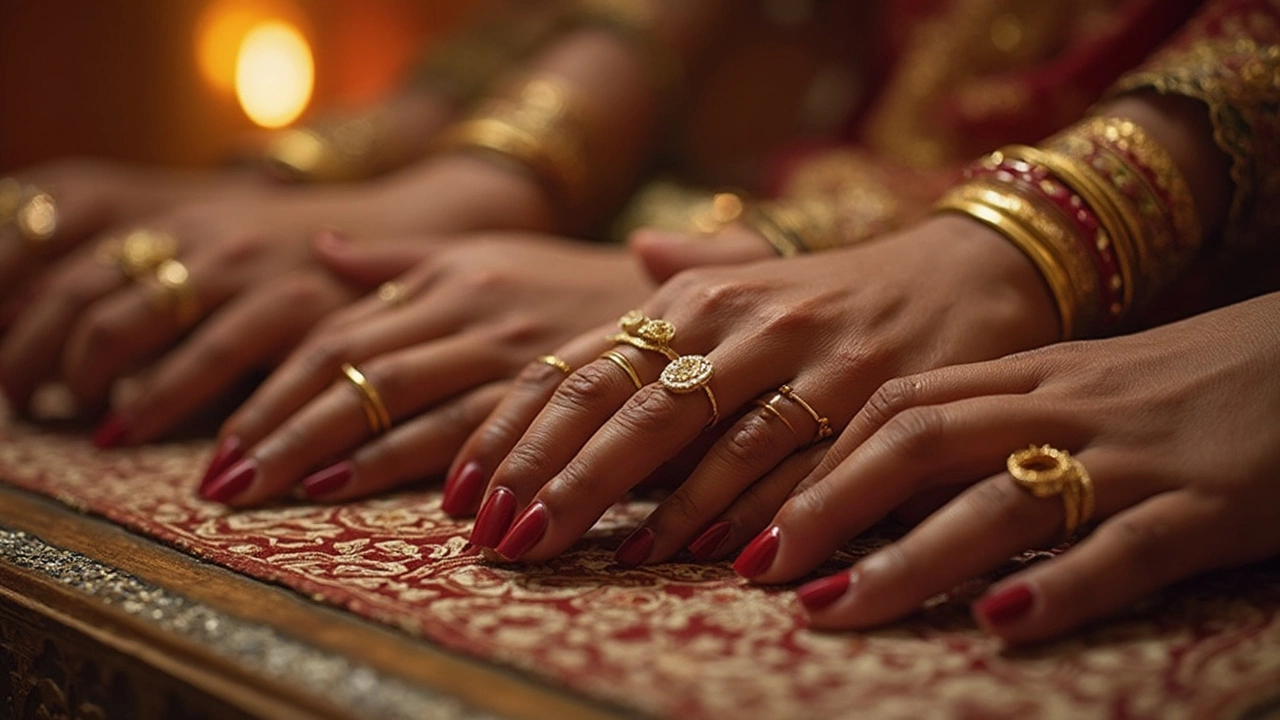
Ever seen someone hesitate before slipping a gold ring onto a finger? There’s more to it than just the right size. Turns out, the finger you choose can say a lot—sometimes even making things awkward if you pick the wrong one, depending on where you live or who you’re with. We’re not just talking about engagement fingers or wedding bands, either.
Some believe that one finger in particular just isn’t right for gold rings. Maybe it’s based on old stories, maybe it’s about practicality, or maybe it’s a mix of both. Wearing gold on the wrong finger can even earn you funny looks at a traditional family event. Forget one-size-fits-all advice—it really helps to know what’s behind these ‘rules’ so you can look confident and avoid ending up in a jewelry faux pas.
It’s not all superstition, though. There are legit comfort and durability reasons, too. Smash a chunky gold ring against your pinky or swipe your thumb with a heavy band, and you’ll feel what I mean. Want your gold ring to last and look great? Getting the finger right is a bigger deal than you might’ve thought.
- The Meaning Behind Finger Choices
- Which Finger Gets a Red Flag for Gold Rings?
- Cultural Beliefs and Superstitions
- Practical Reasons to Avoid Certain Fingers
- Fashion and Comfort Tips for Wearing Gold Rings
- How to Choose the Right Finger for Your Style
The Meaning Behind Finger Choices
Most people don’t realize how much meaning each finger holds when it comes to wearing a gold ring. Each hand and finger tells a different story, and sometimes that little detail can make a big difference, especially in cultures that care a lot about tradition or status.
The ring finger, especially on the left hand, is a classic spot for wedding or engagement rings in places like the US, UK, and much of Europe. Why? Folks have believed for centuries that this finger has a "vein of love"—the vena amoris—that runs straight to the heart. Science says every finger has veins, but this old idea still sticks around and shapes the way people wear rings.
The right hand often signals power or authority, depending on the ring and its placement. In India, for example, you’ll see gold rings worn mostly on the right hand for men—left is sometimes linked to bad luck. Pinkies, meanwhile, used to be all about family crests or club memberships (think old-school mafia movies), but now some folks just use them for a bold style move.
| Finger | Common Meaning | Typical Gold Ring Placement |
|---|---|---|
| Thumb | Willpower, independence | Rare, mostly for statement rings |
| Index | Leadership, ambition | Occasionally used for bold designs |
| Middle | Balance, responsibility | Not as common for big rings |
| Ring | Love, commitment | Most common for gold ring placement |
| Pinky | Status, personal style | Eye-catching, sometimes family jewelry |
For many, picking a finger is mostly about habit. But sometimes, it’s also about clear messages—like not wanting to look married by slipping a gold ring on your left ring finger if you’re single. A little knowledge goes a long way here. Get the meaning right, and you can dodge social confusion or even awkward questions at a party.
Which Finger Gets a Red Flag for Gold Rings?
When it comes to gold ring placement, the index finger often gets flagged. In a lot of traditional Indian families, for example, wearing a gold ring on your left index finger is seen as bad luck or plain inappropriate, unless you’re following religious customs that specifically allow it. The reason? The index finger has long been linked to power, authority, and ego—qualities that, according to some beliefs, should not be "amplified" with something valuable like gold. Instead, priests or traditional healers might only wear gold here as part of a ritual, not as regular jewelry.
The thumb is another finger that raises eyebrows in some circles. While a bold gold ring on the thumb can look cool, certain cultures frown on it. In some old-school communities, it's believed that gold on the thumb blocks energy flow, messes with natural body balance, and might even bring financial setbacks. If you’re into astrology, you’ve probably heard that each finger represents a planet. Wearing gold on the wrong one, like Jupiter’s thumb, is thought by some to throw things out of whack.
Here’s a quick look at common red flags by finger, based on known traditions and practical considerations:
- Left Index Finger: Often avoided in South Asian cultures due to beliefs about power and bad luck.
- Thumb: Can be seen as a no-go for gold ring placement in various traditions and for comfort reasons—rings here can get in the way of daily tasks.
- Middle Finger: Rarely chosen for gold ring wear, mainly because it’s big and the ring might take more knocks and scratches.
On the practical side, think about usability. The thumb and index do the most heavy lifting—holding, gripping, typing—so any bulky or ornate gold ring here is at extra risk for dents, dings, and warping. Jewelers often recommend steering clear for daily wear. A 2023 jewelry care survey found that over 60% of ring repairs come from rings worn on the thumb or index finger, which says a lot.
| Finger | Common Belief/Reason | Practical Risk |
|---|---|---|
| Thumb | Blocks energy, linked to bad luck | High (damage, discomfort) |
| Index | Authority, bad luck in some cultures | High (damage, frequent use) |
| Middle | Neutral, but less popular for gold | Moderate (size/fits awkward) |
If you’re unsure, ask your family about traditions or check with your jeweler. Either way, the safest bets for gold? The ring finger and, if you're feeling adventurous, the pinky. They just don’t carry the same red flags or risk for your favorite piece of gold jewelry.
Cultural Beliefs and Superstitions
When it comes to gold ring traditions, culture has a louder say than you might think. In India, for example, it’s a big no-no to wear a gold ring on the left hand’s middle finger—some even avoid wearing gold on their left hand at all. Why? Because the left side is considered less ‘pure’ than the right, which is used for rituals and important tasks. There’s even a saying in some families: save the left for silver, not gold.
Across the Middle East and parts of South Asia, people usually stick to their right hand for gold rings. There’s a bit of religious tradition in that too—it's believed the right hand brings better luck and positive energy, especially if the gold ring is a gift for a major life event.
Oddly enough, in Western countries, the left hand is usually reserved for wedding and engagement rings, and nobody bats an eye if you wear your gold ring there. But in Russian Orthodox culture, married couples wear rings on the right, making the left hand the ‘wrong’ hand for these special bands.
Here’s a quick look at what’s considered unlucky or taboo with gold rings in different places:
- In some Indian families, gold on the thumb is a no-go. It’s seen as a symbol of arrogance or breaking tradition.
- In parts of Europe, wearing gold jewellery on the ‘ring finger’ means you’re taken—so putting a gold ring there by accident can send the wrong signal at a party.
- In Chinese superstition, wearing heavy gold rings on certain fingers is believed to block your good luck if the metal covers the 'wrong' energy channel.
| Region | Finger to Avoid | Belief/Reason |
|---|---|---|
| India | Left Middle/All Left Fingers | Considered impure for gold |
| Middle East | Left Hand | Right brings luck, left is less favored |
| Western Europe | Ring Finger (if unmarried) | Implies relationship status |
| China | Thumb, heavy rings on wrong fingers | Luck and energy beliefs |
Bottom line: Where you put your gold ring isn’t just about style—it can be about respect, status, or even luck, depending on where you are and who you’re with. Knowing these traditions can help you avoid awkward moments or giving off the wrong impression the next time you show off your new band.

Practical Reasons to Avoid Certain Fingers
Let’s forget tradition for a second—sometimes, the reasons you shouldn’t wear a gold ring on a certain finger are just about real-life comfort and keeping your jewellery in top shape. Not all fingers take the same amount of stress, so your choice can make a big difference.
Think about your thumb. It’s thick, constantly moving, and always at work—gripping, pulling, texting. Gold is softer than a lot of other metals, so rings on the thumb get scratched and bent easily. You’ll see scuffs and maybe even feel your ring getting out of shape way faster compared to less-used fingers.
The pinky might seem like a fun spot, but it’s actually risky for chunky or heavy gold rings. It doesn’t have much muscle or bone to support a solid band, and your ring can slide off without you noticing, especially if your hands get cold. Plus, tight pinky rings can rub your skin raw since that area is extra sensitive.
Index fingers are big on show, but they’re also busy. Reaching for bags, typing, using tools—if you’re wearing a gold ring here, it’s getting bumped around. That’s a recipe for dents and minor injuries, especially if the ring has edges or a raised design. You’ll end up with nicks on both your finger and the ring.
Just to give a picture, check out how common these problems can be, according to jeweler experience surveys:
| Finger | Damage Rate (per year) | Lost Rings (%) |
|---|---|---|
| Thumb | High | 8 |
| Index | Medium | 6 |
| Middle | Low | 2 |
| Ring | Low | 1 |
| Pinky | High | 10 |
As you can see, the pinky and thumb are the trouble spots for most gold jewellery. So unless it’s a special occasion or a super-slim band, maybe rethink putting your gold ring there every day.
Fashion and Comfort Tips for Wearing Gold Rings
If you’ve ever struggled with a gold ring that pinched or slipped off, you know how much the right fit and finger matter. Gold might look amazing, but it’s a soft metal—treat it wrong, and you can bend it or scratch it without even realizing. Finding a design that suits your lifestyle actually keeps your ring looking sharp for longer.
Let’s get real—certain fingers deal with more bumps and knocks. For daily wear, avoid putting your gold ring on your pinky. Pinky rings are often at risk because we use our hands for everything from typing to grabbing groceries. Thumb rings? Cool for some styles, but they can feel clunky, especially with chunky gold jewellery.
Comfort counts as much as style. When checking fit, if you have to force your ring past your knuckle or it spins wildly, swap it out. Ideally, a gold ring should slide on easily and need a tiny twist to come off. Here’s some quick advice for everyday ring-wearers:
- Save heavier, elaborate gold ring designs for your middle or ring finger—they tend to be sturdiest.
- Go snug but not tight; fingers swell in heat and shrink when cold.
- If you stack rings, space them out so the gold surfaces don’t rub and scratch each other.
- Give your gold ring a break if you’re working with tools, gardening, or at the gym.
If you’re worried about comfort and long-term wear, check out this table showing which fingers usually work best for gold jewellery:
| Finger | Comfort | Design Suitability |
|---|---|---|
| Thumb | Low | Bulkier, trend-driven |
| Index | Moderate | Statement, bold |
| Middle | High | Classic, wide bands |
| Ring | Very High | Traditional, engagement/wedding |
| Pinky | Low | Small, delicate |
Your finger shape matters too. Thicker fingers can show off wide bands, while slender fingers do better with narrower gold rings.
And don’t forget—hands change over time. Give your gold rings a quick spin on your finger every once in a while. If there’s a new pinch or a ring suddenly feels loose, it’s worth resizing sooner rather than risking a loss. Keeping both fashion and comfort in mind goes a long way in making sure your gold jewellery always fits—and feels—as good as it looks.
How to Choose the Right Finger for Your Style
Deciding where to wear your gold ring is a mix of showing off your taste, following tradition, and making sure the fit feels good. Start by thinking about what you want your ring to say. Is it for style, for status, or does it have a special meaning? Different fingers send different messages and also handle wear and tear differently.
If you’re after a classic look, most people stick to the ring finger on either hand. The left ring finger is loaded with meaning in most places—think engagement or wedding rings—while the right ring finger tends to be more popular for gold jewellery in countries like India and Russia. Guys often feel comfortable with a signet or simple band on the pinky or index finger. The pinky can look sharp with a slim but bold design, while the index finger is perfect for chunkier styles or traditional family rings.
Comfort is key. Rings with wider bands might feel better on the middle or ring finger because those fingers can handle a bit more weight. Thumb rings are getting more popular, but go for a thinner band to avoid feeling clunky when you grip or grab something. Don’t forget about sizing—thumbs especially change size more than you’d think during the day.
- If your job requires lots of hand movement, avoid wearing a gold ring on your dominant hand’s index or middle finger—these hit stuff constantly.
- For everyday wear, stick to fingers that don’t swell as much, like the ring or pinky finger.
- Mixing metal colors on the same hand? The index finger is great for making your gold ring the star piece.
A recent survey found that 55% of men who wear gold rings for style (not marriage) pick their right hand, while 35% choose the left, and only 10% go for both. Looks like tradition still matters, but there’s plenty of room to play with your look.
| Finger | Common Styles | Best For |
|---|---|---|
| Thumb | Wide bands, chunkier designs | Statement look, casual style |
| Index | Family crests, bold rings | Showing off unique pieces |
| Middle | Moderate width, simple designs | Comfort, balanced look |
| Ring | Classic bands, intricate designs | Tradition, meaningful rings |
| Pinky | Signet rings, slim bands | Subtle statement, old-school style |
Don’t be afraid to try rings on different fingers and see what feels best with your look. Think about balance, both in design and comfort. Your hands are on show more than you think, so make sure your gold ring feels like it belongs there.


